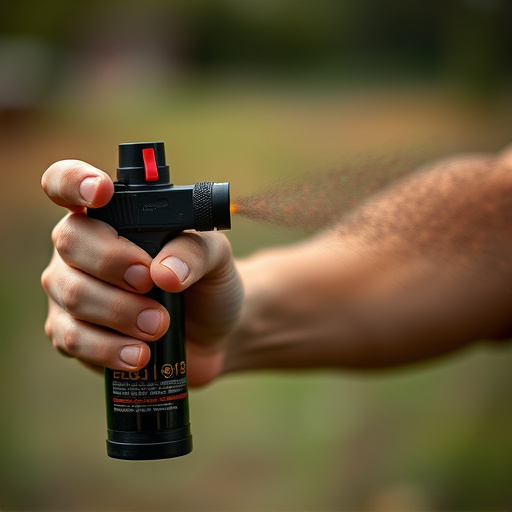Aerosol spray technology has transformed personal defense with defensive pepper spray, an effective tool to deter and incapacitate attackers at 2–3 meter (6–10 foot) range. Key factors include spray type, capsaicin concentration, application technique, environmental conditions, and legal considerations. Proper aiming at sensitive areas like eyes, nose, and mouth, along with understanding local laws and regular training, ensure maximum effectiveness while minimizing harm to bystanders.
“In today’s uncertain world, understanding aerosol spray defense is crucial for personal safety. This comprehensive guide explores defensive pepper spray as a potent tool against attackers. We delve into the technology behind it, dissecting factors that influence its distance and effectiveness. Learn best practices for optimal use in self-defense scenarios, along with essential legal considerations and safety precautions. Maximize your awareness and preparedness by understanding the full spectrum of defensive pepper spray capabilities, including its typical distance range.”
- Understanding Aerosol Spray Technology for Self-Defense
- Factors Affecting the Distance and Effectiveness of Defensive Pepper Spray
- Best Practices for Using Aerosol Spray in Self-Defense Situations
- Legal Considerations and Safety Precautions for Defensive Pepper Spray
Understanding Aerosol Spray Technology for Self-Defense
Aerosol spray technology has revolutionized personal defense strategies, offering individuals a powerful tool to deter and incapacitate attackers at close range. This innovative self-defense mechanism operates by releasing a fine mist of irritants into the air, which can temporarily blind and disorient an aggressor. The key to its effectiveness lies in understanding the defensive pepper spray distance range. Typically, these sprays are designed to be used within 2–3 meters (6–10 feet), ensuring that the user is close enough to deploy the spray effectively without risking inhalation of the irritants themselves.
The precise application and timing are crucial factors when using aerosol spray for self-defense. Users must aim for the attacker’s eyes, nose, and mouth, areas most sensitive to the chemicals, and activate the spray in quick succession. This technology provides a non-lethal but highly effective means of escape or deterrence, empowering individuals to protect themselves in various situations, from street assaults to home invasions.
Factors Affecting the Distance and Effectiveness of Defensive Pepper Spray
Several factors influence the distance and effectiveness of defensive pepper spray when used against attackers. First, the type of spray and its formulation play a significant role. Different brands and varieties have varying levels of capsaicin concentration, which determines the potency and range of the spray. Higher concentrations can provide better protection at longer distances but may also cause more discomfort to the user.
Second, the application technique matters greatly. Proper aiming and the right amount of spray are crucial. Users should target the attacker’s eyes, nose, and mouth, where sensitive nerve endings are located. Inadequate coverage or spraying too lightly might not deter an aggressor effectively. Additionally, environmental conditions such as wind, temperature, and humidity can affect the spray’s trajectory and persistence, impacting its overall performance.
Best Practices for Using Aerosol Spray in Self-Defense Situations
When utilizing aerosol spray for self-defense, understanding best practices is vital. Aim for the attacker’s face—the eyes, nose, and mouth are sensitive areas that can be temporarily disabled by the spray. Maintain a safe distance, typically between 2 to 3 feet, to ensure the spray reaches its target effectively without causing harm to yourself or bystanders.
Remember, defensive pepper spray is most effective when used as a distraction to create an escape route. Practice your technique beforehand, and always be aware of local laws regarding self-defense and the use of aerosol sprays.
Legal Considerations and Safety Precautions for Defensive Pepper Spray
When considering defensive pepper spray as a personal safety measure, it’s crucial to understand the legal landscape surrounding its use. The legality and restrictions vary greatly depending on your location. In many areas, carrying pepper spray for self-defense is permitted but comes with specific regulations. For instance, there are often rules about the type of spray allowed, its capicity, and the distance range at which it can be deployed safely and legally. It’s essential to research local laws to ensure compliance and avoid potential legal repercussions.
Safety precautions should never be overlooked when handling any form of self-defense tool, including defensive pepper spray. Always follow manufacturer instructions regarding usage and storage. Be mindful that pepper spray is not a non-lethal weapon; it can cause severe discomfort and temporary blindness within the specified distance range (typically 2-3 meters). It’s crucial to use it responsibly and only as a last resort when facing an imminent threat. Regular training in its correct application can help ensure your safety and the minimal impact on bystanders.
Aerosol spray defense, particularly defensive pepper spray, offers individuals an effective tool to protect themselves in dangerous situations. Understanding the technology, factors influencing its range and effectiveness, and best practices is crucial for maximizing its utility. By adhering to legal considerations and safety precautions, users can ensure their safety while navigating potential attacker encounters. Remember, knowledge and responsible use are key when employing defensive pepper spray within its recommended distance range.
